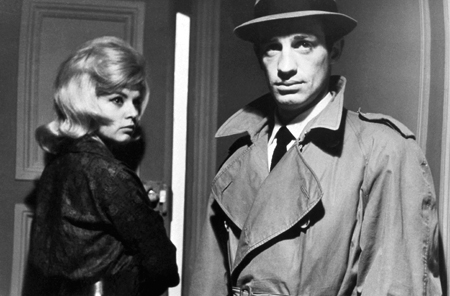|
Reviews of Recent Independent, Foreign, & Documentary Films in Theaters and DVD/Home Video
Written & Directed by: Jean-Pierre Melville, based on the novel by Pierre Lesou. Produced by: Georges De Beauregard & Carlo Ponti. Director of Photography: Nicholas Hayer. Edited by: Monique Bonnot. Music by: Paul Misraki. Released by: Rialto Pictures. Language: French with English subtitles. Country of Origin: France. 108 min. Not Rated. With: Jean-Paul Belmondo, Serge Reggiani, Jean Desailly, Michel Piccoli, René Lefèvre, Aimé de March & Monique Hennessy.
So opens Jean-Pierre Melville’s first in a series of (super) cool and cold homages to American gangster films and film noir. There’s a sense of style not just in how he moves the camera, edits scenes to increase tension, or focuses on a look or gesture, but also in how his hoods are dressed and communicate with just hints of emotions underneath the sleek exteriors. (The gangster’s uniform includes a trench coat and hat, the latter is the translation of doulo, though it also means “rat” in this scenario.) Quite simply, the film’s a world of its own, and one that is a disturbing joy to watch, with characters caught in a game of deceit as in Melville’s Le Samourai, Army of Shadows or Le Cercle Rouge. All, like Le Doulos, are great films, if only for the pure expression through a genre style. The story is, in fact, pure pulp: Maurice (Serge Reggiani), just out of prison, plots a jewel heist. Before he and his partner have cracked the safe, the police case the neighbor. The thieves escape with the police in pursuit, with one shot dead and Maurice wounded, who suspects right away that he has been betrayed by Silien (Jean-Paul Belmondo). The details of how and why the robbery went awry become one of the great pretzel twists in French film noir. Loaded with punchy dialog right out of a 25-cent paperback (“In this business, you either end up a bum, or filled with lead”), and the serenely light but effective xylophone doodling score by Paul Misraki, the film is an intense masterstroke of understatement. As a smooth operator of underdog criminals, Belmondo may arguably (and I’m sure it would be quite the argument) be better here than in Breathless as far as ultra-hip gangsters go. He’s got some of the vigor and panache of Bogart, and unlike in Breathless, he doesn’t flinch or coast along on a self-conscious attitude. It’s never a totally sure thing if Silien is hero or heel, which gives Belmondo the advantage in playing both sides for the camera.
The cinematography, meanwhile, is a sumptuous feast for those not content with Paris having to be always shown as Paris. Melville’s locations
are dank and ambiguous – you’re not bound to find them easily as a tourist. But what really impresses with Le Doulos, like the best moments in
Melville’s films, is how he subverts the expectations of the classic ‘40’s American crime films to a level that is pure existentialism. How does one
go about leading a life of crime when there’s no honor even among thieves? The final scene emphasizes that, in Melville’s world, tragedy
still comes following a wink to the hat as it’s adjusted a little bit in the mirror, right before the final fall to death.
Jack Gattanella
|

